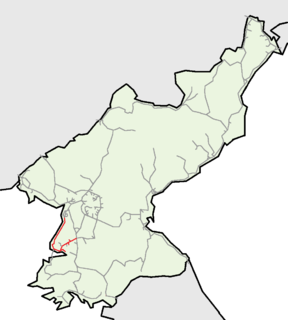
The P'yŏngbu Line is an electrified standard-gauge trunk line of the Korean State Railway running from P'yŏngyang to Kaesŏng in North Korea and further south across the DMZ to Seoul in South Korea; the name comes from the two (theoretical) termini of the line: P'yŏngyang and Pusan.

The P'yŏngnam Line is an electrified standard-gauge trunk line of the Korean State Railway in North Korea, linking P'yŏngyang with the port city of Namp'o and the hot springs at P'yŏngnam Onch'ŏn. The length of the line is 89.9 km (55.9 mi).
Kangsŏ Station is a railway station in Kiyang-dong, Kangsŏ-guyŏk, Namp'o Special City, North Korea, on the P'yŏngnam Line of the Korean State Railway. It is the starting point of the Taean Line and of the Posan Line.

The Sŏhae Line, also known as the Anju Colliery Line, is a partially electrified standard-gauge secondary line of the Korean State Railway in South P'yŏngan Province, North Korea, running from Mundŏk on the P'yŏngŭi Line to Hwap'ung. The line is electrified between Mundŏk and P'yŏngnam Sŏho and between Ch'ŏngnam and Sŏsi.

The Sŏhae Kammun Line, or West Sea Barrage Line is a non-electrified standard-gauge secondary line of the Korean State Railway located entirely within Namp'o Special City, North Korea, and running from Ch'ŏlgwang on the Ŭnnyul Line to Sillyŏngri on the P'yŏngnam Line.

The Ryonggang Line is a non-electrified standard-gauge secondary line of the Korean State Railway located entirely within Namp'o Special City, South P'yŏngan Province, North Korea, running from Ryonggang on the P'yŏngnam Line to Mayŏng. The line connects to the Husan Line to Yangmak at Husan.

The Taean Line is an electrified standard-gauge secondary line of the Korean State Railway in Namp'o-t'ŭkpyŏlsi, North Korea, running from Kangsŏ in Kangsŏ-guyŏk on the P'yŏngnam Line to Taean Freight Station in Taean-guyŏk.

The P'yŏngdŏk Line is an electrified standard-gauge trunk line of the Korean State Railway in North Korea running from Taedonggang Station in P'yŏngyang, where it connects to the P'yŏngbu, P'yŏngnam, P'yŏngra and P'yŏngŭi Lines, to Kujang, where it connects to the Manp'o and Ch'ŏngnyŏn P'arwŏn Lines. The total length of the line is 192.3 km (119.5 mi).
Posan Station is a freight-only railway station in Posan-dong, Ch'ŏllima-guyŏk, Namp'o Special City, North Korea. It is the terminus of the Posan Line from Kangsŏ on the P'yŏngnam Line of the Korean State Railway.
Namp'o Station is a railway station in Hanggu-guyŏk, Namp'o Special City, North Korea on the P'yŏngnam Line of the Korean State Railway, as well as the starting point of the Tojiri Line. There is an engine house northwest of the station in Munhwa-dong, Hanggu-guyŏk.
Tŏktong Station is a railway station in Taedae-dong, Waudo-guyŏk, Namp'o Special City, North Korea on the P'yŏngnam Line of the Korean State Railway.
Sillyŏngri Station is a railway station in Sillyŏng-ri, Waudo-guyŏk, Namp'o Special City, North Korea on the P'yŏngnam Line of the Korean State Railway; it is also the northern end of the Sŏhae Kammun Line.
P'yŏngnam Onch'ŏn Station is a railway station in Onch'ŏn-ŭp, Onch'ŏn county, Namp'o Special City, North Korea, the northern terminus of the P'yŏngnam Line of the Korean State Railway; it was also the southern terminus of the now-closed Namdong Line.
The Namdong Line was a non-electrified secondary railway line of the Korean State Railway in South P'yŏngan Province, North Korea, from P'yŏngnam Onch'ŏn on the P'yŏngnam Line to Namdong, where it connected to the Namdong Branch of the Sŏhae Line.
The Tojiri Line is a non-electrified secondary railway line of the Korean State Railway in Namp'o Special City, North Korea, from Namp'o on the P'yŏngnam Line to Tojiri.
The Namp'ohang Line, or Namp'o Port Line, is an electrified secondary railway line of the Korean State Railway in Namp'o Special City, North Korea, from Sinnamp'o on the P'yŏngnam Line to Namp'ohang.
The Chamjilli Line is a non-electrified freight-only railway line of the Korean State Railway in South P'yŏngan Province, North Korea from Kangsŏn on the P'yŏngnam Line to Chamjilli.
The P'yŏngyanghwajŏn Line, or P'yŏngyang Thermal Power Plant Line, is an electrified freight-only railway line of the Korean State Railway in Pot'onggang-guyŏk and P'yŏngch'ŏn-guyŏk, P'yŏngyang, North Korea, running from Pot'onggang on the P'yŏngnam Line to P'yŏngch'ŏn, with a branch to the P'yŏngyang Thermal Power Plant (P'yŏngyanghwajŏn), from which the line gets its name).
The Changsang Line is an electrified freight-only railway line of the Korean State Railway in South P'yŏngan Province, North Korea, running from Hyangjang on the P'yŏngdŏk Line to Changsang.






